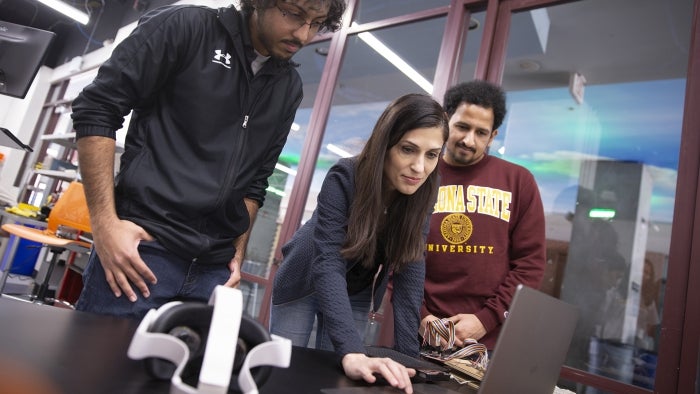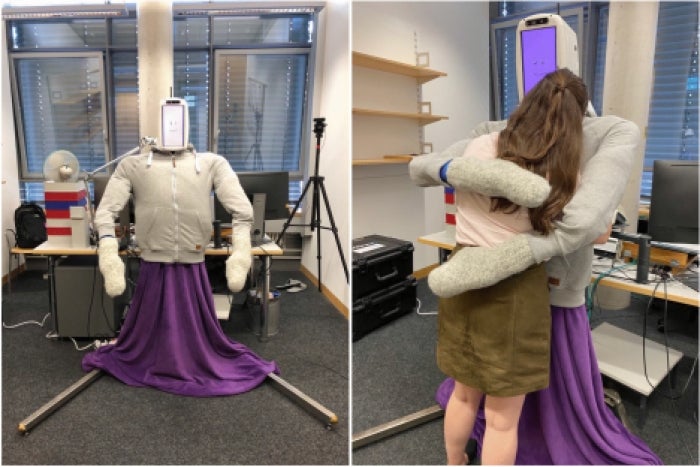Perfecting the pulse of haptics

Hasti Seifi, an assistant professor of computer science in the Ira A. Fulton Schools of Engineering at Arizona State University, has been awarded the 2024 Faculty Early Career Development (CAREER) Award from the National Science Foundation for her work in making touch technologies more accessible. Photographer: Erika Gronek/ASU
A warm hug. A friendly handshake. The bump of a stranger’s elbow.
As newborns, touch is the first sense we engage with and, some would argue, it remains the most important throughout our lives. But in a world where people increasingly interact with each other via screens and devices, it’s easy to lose touch with our sense of touch.
“When we use digital technologies, we miss the physical feedback that we get in the real world,” says Hasti Seifi, an assistant professor of computer science and engineering in the School of Computing and Augmented Intelligence, part of the Ira A. Fulton Schools of Engineering at Arizona State University.
Seifi’s work in the field of haptic technology, or haptics, has earned her a CAREER Award from the National Science Foundation (NSF). The award provides a five-year grant to support early-career faculty in their promising research pursuits.
Haptics refers to a family of programmable touch technologies that enable devices to provide feedback to our bodies and skin through mechanisms such as vibrations, force and friction. Most people are familiar with touchscreens such as those on phones and electronic tablets, as well as vibrations from video-game controllers, but Seifi’s proposed research seeks to help expand and broaden haptic use.
A helping hand for haptic developers
“My proposal is about democratizing haptic design,” Seifi says.
Her CAREER Award will fund research designed to answer three basic questions: How do people describe haptic signals? How do they perceive similar signals? And, finally, how can the process of getting haptic feedback be made faster and more accessible?
Approaching both graduate and undergraduate students, Seifi will interview subjects from diverse disciplinary backgrounds, including engineering and the arts, to determine how they respond to more than 300 haptic signals. This information will be used to create a language library that designers can tap to make informed development decisions. Her team will later create a set of web-based tools that will help users incorporate haptics into a wide array of applications.
Streamlining the process of making haptic devices is important to Seifi, who explains that many researchers are using processes that rely on a lot of trial and error.
Seifi’s vision of democratizing haptic design involves bringing this technology to all sorts of devices that enrich day-to-day life. She points out that today’s haptic devices, such as phones, rely heavily on visuals, requiring users to look at the screen. However, the use of many devices, such as vehicle navigation systems, could be made much safer if users could receive feedback without having to look away from the road.
Seifi foresees much wider use of haptics in medical devices, wearables and technology designed to improve accessibility for people with disabilities.
She also says haptics can help improve human connections.
“A lot of times people might live far from their relatives,” she says. “Haptics can help close that distance.”
Award is a promising gesture toward future success
Seifi’s CAREER Award is the next step in building her already dynamic portfolio of work. She previously worked with other researchers to develop additional design guidelines for autonomous hugging robots.
“A lot of the work in robotics is focused on automation — such as making things faster and improving performance,” Seifi says. “But hugging has a lot of health benefits.”
Katherine J. Kuchenbecker, director of the Haptic Intelligence Department at the Max Planck Institute for Intelligent Systems in Stuttgart, Germany, believes that Seifi’s work will have a powerful impact.
“Rather than delighting in the exclusivity of haptics, Dr. Seifi is working to remove those barriers so that a much wider range of people can benefit from and contribute to this field,” Kuchenbecker says. “That is what she calls democratizing haptics.”
“We’re working hard to foster this type of collaborative environment across the various disciplines in engineering, to become a place where research and education meet,” says Ross Maciejewski, director of the School of Computing and Augmented Intelligence. “Seifi’s work will provide rich learning opportunities for our students even as it creates big strides in haptic technology development.”
In fact, it was ASU’s strength in robotics that led Seifi to call the university her home. After receiving her doctorate from the University of British Columbia and a stint at the University of Copenhagen, she landed in Arizona after inspiring talks with Fulton Schools faculty.
“Haptics is an enchanting research topic for specialists, since it blends mechanical engineering, electrical engineering, computer science and psychology, plus many applications,” Kuchenbecker says. But it is only through research like Seifi’s “that haptic feedback will have the societal impact that many people foresee but that has long lagged behind expectations.”
For now, Seifi will continue her efforts to put haptics designers in touch with their future. She says she is excited about the implications the NSF award will have for her future and the prospect of being an expert in the expanding field.
“This grant is supposed to shape the career of a junior faculty member,” she says. “The idea is that, at the end, you are known for that type of research.”
Do you need a hug today?
The news media and even the U.S. surgeon general continue to sound the alarm over the emerging loneliness epidemic, with the New York Times declaring that being lonely is damaging American health.
Because of this, researchers such as ASU engineer Hasti Seifi study a form of haptics called remote social touch — the idea of using robots or devices to help people maintain physical connections even when separated from each other.
“There have been all kinds of studies that show that hugging has long-term health benefits,” Seifi says. “When we receive prolonged hugs of 20 seconds or more, our body releases oxytocin, which helps us calm down and reduces blood pressure.”
Seifi worked as part of a research team that created additional guidelines for designing interactive hugging robots. Because hugs lasted longer than three seconds and often involved other touches, the team defined four intra-hug gestures: holding, rubbing, patting and squeezing.
“It’s a challenging problem to have such tight, close contact between a robot and a human, and also provide a positive experience for the user,” Seifi says.
In the future, the research team hopes to make robots socially intelligent in various physical interactions.
Seifi believes that haptics can help address some of the problems of the digital age.
“The hope is to create an experience that feels human-like and friendly and live,” she says.
More Science and technology

ASU-led space telescope is ready to fly
The Star Planet Activity Research CubeSat, or SPARCS, a small space telescope that will monitor the flares and sunspot activity of low-mass stars, has now passed its pre-shipment review by NASA.…

ASU at the heart of the state's revitalized microelectronics industry
A stronger local economy, more reliable technology, and a future where our computers and devices do the impossible: that’s the transformation ASU is driving through its microelectronics research…

Breakthrough copper alloy achieves unprecedented high-temperature performance
A team of researchers from Arizona State University, the U.S. Army Research Laboratory, Lehigh University and Louisiana State University has developed a groundbreaking high-temperature copper alloy…




